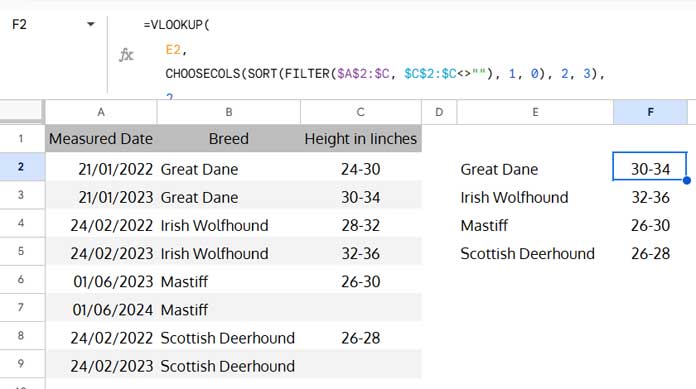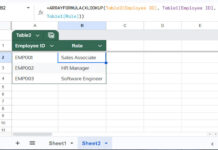There’s no built-in function in Google Sheets to retrieve the latest non-blank value by date—but you can achieve it using a custom formula made with native functions.
When working with multiple records (rows) related to a specific category (like a user or item), you may want to find the latest non-blank value among them based on date.
Real-Life Example
Let’s say you bought 1 liter of cooking oil on 25/07/2023, 06/08/2023, and 23/08/2023, with prices recorded as $3.52, $4.00, and blank (because you lost the bill).
In this case, the most recent price should not return a blank cell. Instead, it should return $4.00, the last known price.
This issue commonly occurs when using Google Forms to collect data into Google Sheets. For instance, a user might resubmit a form to update previously entered data.
These types of datasets typically include:
- A date or timestamp column
- A category column
- A values column (which may have blanks)
To look up the latest non-blank value by date in Google Sheets, we can use a combination of the FILTER, SORT, and VLOOKUP functions—or build a more advanced array formula.
Example: Get the Latest Non-Blank Value by Date in Google Sheets
Consider a table with three columns:
- Measured Date (
A) - Breed (
B) - Height in Inches (
C)
| Measured Date | Breed | Height in Iinches |
| 21/01/2022 | Great Dane | 24-30 |
| 21/01/2023 | Great Dane | 30-34 |
| 24/02/2022 | Irish Wolfhound | 28-32 |
| 24/02/2023 | Irish Wolfhound | 32-36 |
| 01/06/2023 | Mastiff | 26-30 |
| 01/06/2024 | Mastiff | |
| 24/02/2022 | Scottish Deerhound | 26-28 |
| 24/02/2023 | Scottish Deerhound |
To return the latest non-blank height per dog breed, enter this formula in cell F2:
=VLOOKUP(
E2,
CHOOSECOLS(SORT(FILTER($A$2:$C, $C$2:$C<>""), 1, 0), 2, 3),
2,
FALSE
)Then drag it down to apply to other breeds in the column.

Array Formula Version
To return values for multiple breeds at once, use:
=ArrayFormula(
VLOOKUP(
E2:E5,
CHOOSECOLS(SORT(FILTER(A2:C, C2:C<>""), 1, 0), 2, 3),
2,
FALSE
)
)This array formula returns the latest non-blank value by date in Google Sheets, specifically from the “Height in Inches” column, for each breed in the criteria range.
Formula Breakdown
Let’s understand how this formula works:
FILTER(A2:C, C2:C<>""): Filters out rows where the value column (height) is blank.SORT(..., 1, 0): Sorts the filtered data in descending order by the date in column A (latest dates first).CHOOSECOLS(..., 2, 3): Rearranges columns so thatVLOOKUPworks correctly, making column B (Breed) the lookup column and column C (Height) the return column.VLOOKUP(E2, ..., 2, FALSE): Looks up the breed from cell E2 and returns the height from the most recent non-blank entry.
Notes
E2orE2:E5: Criteria range (breeds to look up)A2:C: The dataset rangeC2:C: The column from which we want the latest non-blank value (height)
Your dataset may vary, so understanding the logic behind the formula will help you adapt it to different scenarios.
Related Resources
- Lookup Latest Value in Excel and Google Sheets
- How to Lookup Latest Dates in Google Sheets
- Retrieve the Earliest or Latest Entry Per Category in Google Sheets
- Combine Rows and Keep Latest Values in Google Sheets
- Highlight the Latest Value Change Rows in Google Sheets
- How to Highlight the Latest N Values in Google Sheets
- Merge Duplicate Rows and Keep Latest Values in Excel





















